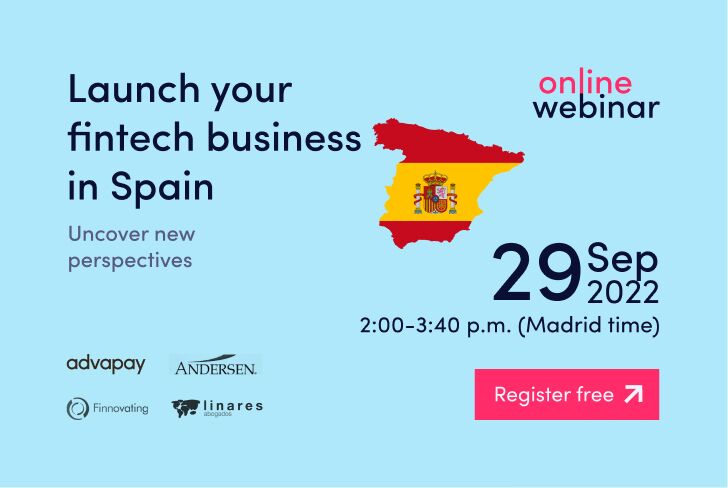Today Advapay interviews Miguel Linares, founding partner of Linares Abogados. He has advised financial entities for more than 25 years and now concentrates on Spanish fintech and crypto companies. Miguel will also be the speaker of online webinar “Launch your Fintech business in Spain”. Register here to book you space.
Here, Miguel offers valuable insight into the many considerations that need to be made for submitting an application for an E-money Institution, Payment Institution or crypto licence in Spain. This interview will teach you more about important aspects of the licencing process, such as average duration, common applicant mistakes, crypto registration, team preparation and more…
1. How long does it take to obtain a license in Spain? How does the quality of the application affect things?
I would say that much depends on the client, but there are two factors that reduce the time needed to obtain the license:
- Submitting a solid project with a clear and defined business model
- The ability to quickly answer Bank of Spain information requirements
In that scenario, 12 months would be reasonable for Spanish fintech company to obtain a licence.
2. What does The Bank of Spain pay attention to when evaluating applications?
The Bank of Spain conducts a thorough review of every document provided in the application process and requires clear and detailed explanations for each of them. However, the essentials are related to the business model.
Basically:
- Business Plan and Financial Forecast
- Structural organisation
- Shareholding structure
- Outsourced services
- Target market
There are other formalities aside from this, such as IT-related questions and others that we prepare with no requirement for assistance from the entity. All these can be handled just by being diligent.
Register free for our online webinar “Launch you fintech business in Spain”:

3. Could you provide some tips or common mistakes you would highlight to Spanish fintech teams preparing the application?
My three tips are:
- Keep it simple: you know the services you are an expert in. Don’t complicate the file just to get authorised for one or two more services. You will have the chance to expand the license once you’re up and running.
- Avoid marketing names for the services: the Bank of Spain is familiar with the services as described in the EU Directives and the EBA guidelines (issuing of e-money, transfers, card payments, PIS, etc.). If the submission refers to terms like “Corporate solution” or “Customer experience service”, the Bank of Spain may get confused with the services included in each “pack”.
- Appoint three contact individuals to complete the file: one knowledgeable in the business model in general; another who’s an expert in IT matters; and a third one for the numbers.
Three common mistakes:
- Too much outsourcing: if that is the case, the Bank of Spain will consider the project an “empty box”, and you’ll have trouble getting it authorised.
- Material changes during the process: like the CEO, a new service or the target market. This will lead the Bank of Spain to reevaluate the whole submission.
- Inconsistencies: it is advisable not to use multiple terms for different elements e.g. client/customer/end-user; partner/agent; e-wallet/wallet/wallet account; transfer/credit transfer/wire transfer. Doing so will only make the file confusing. One term for each concept should be chosen and maintained throughout the file.
4. What does an ideal Spanish fintech team look like to the eyes of the regulator? (number, roles, residency)? Which functions and roles should be performed/located in Spain, and which ones can stay abroad?
The minimum number of people in a team should be 3.
However, if you do go for the minimum, they should be senior, 100% dedicated and have support from the parent company to hire junior officers.
Also, bear in mind that this depends on the size of the project. If you are planning to start with a big volume of business, it won’t be feasible with a small team of 3 people.
The number of necessary team members may vary depending on the business model submitted. In that sense, a business model with fewer activities (for example, only money remittance) might require fewer team members than another model with more (for example, e-money + payment transactions + AIS + PIS+ acquiring + issuing), which will require a larger organisational structure and a higher number of team members.
We usually suggest the following as a minimum structure of a Spanish fintech company:
At least one director, who shall reside in Spain and preferably speak Spanish, in order to directly communicate with the authorities.
The roles/functions to cover are:
- Operations
- Compliance and AML
- Finance
- Commercial
- IT
That said, it should be noted that the Director could also be in charge of one of the described roles (preferably, operations). Operations and finance could be managed by one person, and IT could be completely outsourced.
5. What are the differences between API and AEMI?
Both models can basically render the same services: transfers, card payments, direct debits, payment accounts, small credits, FX, payment initiation and account information.
From a legal point of view, funds in payment institutions should not be held in the long term. This limitation does not apply to e-money institutions.
Before, differences were larger, but development of the technology has reduced them. For instance, EMIs could “affect” an amount of funds to a card and those funds were not linked to any account, only to the card. That made payments safer and provided clients with a better payment organisation. Nowadays, the ubiquity of mobile phones and improvement of security measures have caused both types to operate in a similar way.
Nevertheless, if we look forward, we can observe that MiCA regulation, on crypto trading, mentions EMIs, not PIs. Thus, the future may bring with it new differences between the two models.
6. What is the MiCA regulation mentioned?
MiCA answers to Markets in Crypto Assets Regulation. In other words, the legal environment of crypto trading and its custody. Please note that the term crypto-asset is much wider than crypto-currency. Among crypto-assets, we can find any kind of crypto investments, like NFT (Non-Fungible Tokens).
MiCA regulations will be in force soon. Until that moment, crypto trading entities are only subject to AML and some advertising and transparency rules. In Spain, we already have a crypto registry managed by the Bank of Spain. I encourage any entity involved in crypto to register there. It’s best to be on the safe side at all times.
Besides that, the buying and selling of crypto-assets payments will occur, which is why the role of EMIs will be so relevant in this sector.
7. How is this crypto registration proceeding?
It’s nothing to do with the EMI or PI authorisations. It is basically concentrated on AML obligations, with some formalities of the company and its directors, together with a brief description of the business model.
Registration can be obtained within a month of the submission, as our experience in prior cases allows us to complete the documentation accurately.
Meet Miguel Linares at the webinar “Launch your Fintech business in Spain”
3:00 – 3:15 (Madrid time) – What to take into account when you’re working on your application, Linares Abogados
Beyond following all the requirements of the EBA guidelines and the Bank of Spain, many practical questions may help accelerate an authorisation. The tips we will provide are the product of 25 years of dealing with supervisors. Clear and detailed explanations, simple business models, and consistent documents may be the foundation, but there is more.
Also meet Diana López Ricardo, associate of Linares Abogados:
3:15 – 3:25 (Madrid time) – Crypto licensing in Spain: requirements, authorisation, legal construction for crypto, Linares Abogados
Anticipating to MiCA is more than advisable and being registered presumes being in the right side. We will explain how one of our clients was the first crypto company registered and how to keep a process before the Bank of Spain simple.
Register free for our on-demand webinar “Launch you fintech business in Spain”:








